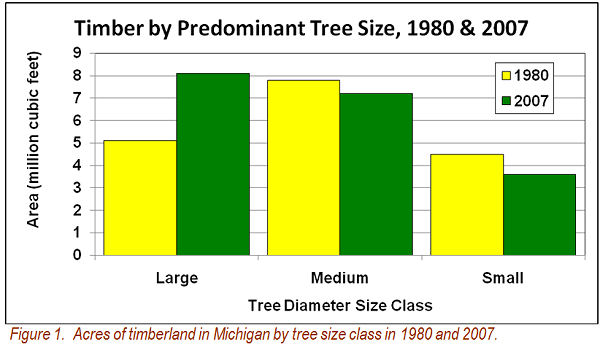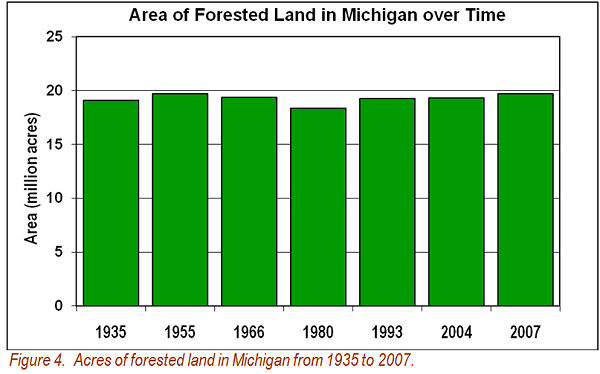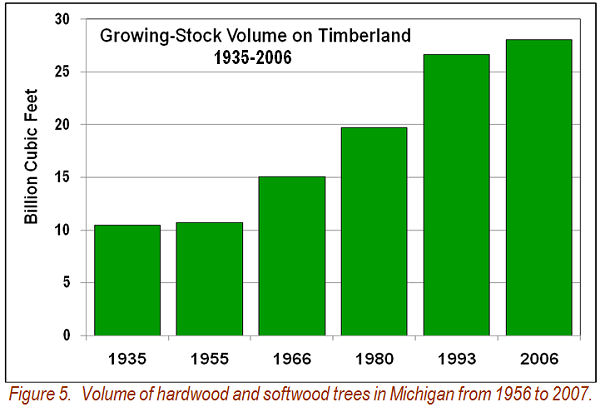| Introduction | Forest Types | |
| Forest Characteristics | Management | |
| Forest Contributions | Special Considerations | |
| The Forest Plan | Assistance |
| Introduction | Forest Types | |
| Forest Characteristics | Management | |
| Forest Contributions | Special Considerations | |
| The Forest Plan | Assistance |
![]()
FOREST MANAGEMENT GUIDELINES FOR MICHIGAN |
Characteristics of Michigan’s Forests Michigan's temperate forests teem with plant and animal life, provide outdoor recreation opportunities, protect and enhance air and water quality, and support thousands of jobs. They contribute billions of dollars to Michigan’s economy each year. Michigan forests touch our lives each day. Forested ecosystems include liv ing and non-living components combined into a much broader landscape diversity mix. The mix of biotic components helps define biodiversity. In the case of forests, the kinds of vegetation present determine the kinds of mammals, birds, amphibians, and other organisms which can survive. In 2007, Michigan's statewide forest inventory (USDA Forest Service’s Forest Inventory and Analysis program) identified over 100 different tree species. The forest also contains other living components which are part of its overall health. These include lichens, mosses, dead and/or downed woody vegetation, fungi, and herbaceous plants. The relationship of these many components to one another creates different but important habitat. Examples are the edge between various forests or land uses and the presence of aquatic systems. Forests dominate Michigan's landscape. In 2007, they covered 54% of the total land area, representing 19.7 million acres. Nearly all of these forest lands meet minimum tree growth productivity standards (20 cubic feet per acre per year) to produce commercial timber crops, qualifying as timberland. Originally intended for industrial wood production, this classification provides a good measure of the forest's potential to produce a wide array of goods and services. Timberland area has increased 10%, to 19.2 million acres, since 1980. |
||
 |
Michigan's forests continue to mature and regenerate, altering forest structure continually. One measure of this process is reflected in the statewide forest inventory. Since 1980, Michigan's forest acreage of large diameter trees (roughly, trees greater than 10 inches) increased 59%; medium diameter (5 to 10 inch trees) acreage decreased 6%; and small diameter (trees smaller than 5 inches) decreased by 19% (Figure 1). Michigan’s forests are growing in area and size. The trend towards maturity in Michigan's forests provides a variety of management opportunities, such as managing for old growth attributes, harvesting mature trees, improving structural diversity, or regenerating young forests. | |
|
Certain tree species in the forest grow near one another due to similar soil, moisture, climate, terrain, and past history. These tree species communities are called forest types and they can be categorized into forest type groups. Hardwood forest type groups (broadleaf deciduous tree species like oak, aspen, and maple) are the most common in Michigan forests. They account for approximately 75% of the forest land. Softwood forest type groups (comprised of tree species like pine, spruce, and cedar) account for the remainder. The two largest forest type groups in Michigan are maple‑beech‑birch (commonly referred to as northern hardwoods) at 6.7 million acres and aspen-birch at 3.4 million acres (Figure 2). | |
|
Private owners hold 63% of the state's timberland acres. They include 444,000 private forest land owners with an average ownership of 27 acres. Non‑industrial private (farmers, individuals, hunt clubs, etc.) ownership is 49% of the total (Figure 3). Corporate and forest industry ownership is 14% of the state total. These collective private holdings have a range of management objectives, including investment, recreation, and scenery. These owners generally have a strong land ethic and respond to opportunities to improve their property's values. Public ownership accounts for the remaining 38% of the total timberland base. National forests in Michigan include the Ottawa, Hiawatha, and the Huron‑Manistee, which represent 14% of the total. State-owned forest lands represent 21% of the total. A small fraction of public ownership is held by counties, municipalities, and various federal agencies. Principal ownership objectives of public lands include community stability through support for timber and recreational industries and the more naturalistic values associated with such things as environmental services and wild lands. Tribal governments, non-government conservation organizations, hunt clubs, and other private organizations account for the “other” timberland owners. | |
|
||
 |
 |
|
 |
Michigan's forests are currently growing twice as much wood (736 million cubic feet) as is being removed (363 million cubic feet) from the timberland base each year (Figure 6). Net growth represents growth minus mortality. Removals of wood include both harvests and diversions from timberland. Mortality due to old age, fire, wind, insects, and disease was 277 million cubic feet. In this same period, Michiganders consumed 740 million cubic feet of wood products (paper, lumber, furniture, etc.). | |
Michigan's surplus growing stock (annual net growth less removals) is among the largest in the nation, but there is potential to increase growth even more. Given favorable climate and soils and using forest management in a timely manner, growth can be increased by assuring fully stocked acres. Additional increases in wood growth can occur through the use of more active forest management techniques such as thinning and planting genetically improved trees. |
||

This website is maintained by Bill Cook, Michigan State University Extension
Forest in the Upper Peninsula. Comments, questions,
and suggestions are gratefully accepted.
Last update of this page was 9 January, 2014
This site is hosted by School of Forest Resources and Environmental Science at Michigan Technological University.